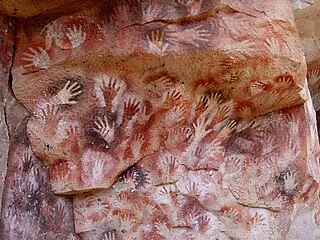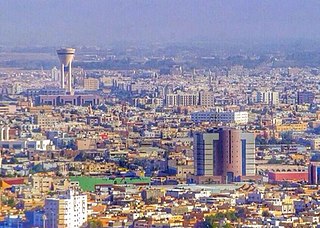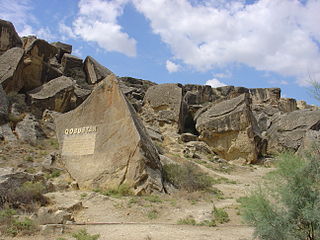
In archaeology, cave paintings are a type of parietal art, found on the wall or ceilings of caves. The term usually implies prehistoric origin. These paintings were often created by Homo sapiens, but also Denisovans and Neanderthals; other species in the same Homo genus. Discussion around prehistoric art is important in understanding the history of the Homo sapiens species and how Homo sapiens have come to have unique abstract thoughts. Some point to these prehistoric paintings as possible examples of creativity, spirituality, and sentimental thinking in prehistoric humans.

A petroglyph is an image created by removing part of a rock surface by incising, picking, carving, or abrading, as a form of rock art. Outside North America, scholars often use terms such as "carving", "engraving", or other descriptions of the technique to refer to such images. Petroglyphs, estimated to be 20,000 years old are classified as protected monuments and have been added to the tentative list of UNESCO's World Heritage Sites. Petroglyphs are found worldwide, and are often associated with prehistoric peoples. The word comes from the Greek prefix petro-, from πέτρα petra meaning "stone", and γλύφω glýphō meaning "carve", and was originally coined in French as pétroglyphe.

In the history of art, prehistoric art is all art produced in preliterate, prehistorical cultures beginning somewhere in very late geological history, and generally continuing until that culture either develops writing or other methods of record-keeping, or makes significant contact with another culture that has, and that makes some record of major historical events. At this point ancient art begins, for the older literate cultures. The end-date for what is covered by the term thus varies greatly between different parts of the world.

Ḥaʼil Province, also known as the Ha'il Region, is one of the 13 provinces of the Kingdom of Saudi Arabia. It is the eighth-largest province by area at 103,887 km2 (40,111 sq mi) and the ninth-largest by population, with the population in 2019 being 731,147. The province accounts for roughly 2% of the population of the country and is named for its largest city, Ha'il. Other populous cities in the province include al-Ghazalah, Shinan and Baq'aa. The region is famous for the twin mountain ranges of 'Aja and Salma, and for being the homeland of historic symbol of curiosity and generosity, Hatim al-Ta`i.

Tabuk is the capital city of the Tabuk Region in northwestern Saudi Arabia. It has a population of 594,350. It is close to the Jordan–Saudi Arabia border and houses the largest air force base in Saudi Arabia.

In archaeology, rock art is human-made markings placed on natural surfaces, typically vertical stone surfaces. A high proportion of surviving historic and prehistoric rock art is found in caves or partly enclosed rock shelters; this type also may be called cave art or parietal art. A global phenomenon, rock art is found in many culturally diverse regions of the world. It has been produced in many contexts throughout human history. In terms of technique, the four main groups are:
Sarmishsay is located in the Karatau Mountain Range in the Nurata District of Navoiy Region of Uzbekistan. The gorge contains archeological remains dating back as far as the Stone Age, including two petroglyph sites with a total of 10,000 ancient rock carvings. According to UNESCO, it is the largest and most important rock art monument in Uzbekistan.

Gobustan State Historical and Cultural Reserve is located west of the settlement of Gobustan, about 40 miles (64 km) southwest of the center of Baku. It was established in 1966, when the area was declared a national historical landmark of Azerbaijan in an attempt to preserve the prehistoric rock carvings, mud volcanoes and musical stones in the region.

Dawadmi or Ad Dawadimi is a town in Riyadh Province, Saudi Arabia. Google Maps spells the name as Al Duwadimi. As of the 2022 census it had a population of 86,861 people. The town is mostly inhabited by the tribe of Banu 'Utaybah.
Ancient North Arabian (ANA) is a collection of scripts and a language or family of languages under the North Arabian languages branch along with Old Arabic that were used in north and central Arabia and south Syria from the 8th century BCE to the 4th century CE. The term "Ancient North Arabian" is defined negatively. It refers to all of the South Semitic scripts except Ancient South Arabian (ASA) regardless of their genetic relationships.

Al-Ula is an ancient Arabic oasis city located in Medina Province, Saudi Arabia. Situated in the Hejaz, a region that features prominently in the history of Islam as well as several pre-Islamic Semitic civilizations, al-‘Ulā was a market city on the historic incense route that linked India and the Persian Gulf to the Levant and Europe.
Thirteen ancient towns have been discovered in Saudi Arabia up to the present day. These include Qaryat al-Fāw, the Al-Ukhdūd archeological area, Hegra, Jubbah, Tārūt, Al-Shuwayḥaṭiyah, Thāj, Taimaa and Dūmat Al-Jandal. There are still more ancient towns in Saudi Arabia, but little information is currently available on them. Saudi Arabia occupies a unique and distinctive geographic location, bridging civilizations between continents. In ancient times the Arabian peninsula served as a corridor for trade; therefore it saw the beginning of many civilizations, the relics of which are still evident today. The Saudi government has recently established the Saudi Commission for Tourism and Antiquities, which is responsible for the preservation of these cities.

The history of cave paintings in India or rock art range from drawings and paintings from prehistoric times, beginning in the caves of Central India, typified by those at the Bhimbetka rock shelters from around 10,000 BP, to elaborate frescoes at sites such as the rock-cut artificial caves at Ajanta and Ellora, extending as late as 6th–10th century CE.
Archeological sites in Azerbaijan first gained public interest in the mid-19th century and were reported by European travellers.

Bir Hima is a rock art site in Najran province, in southwest Saudi Arabia, about 200 kilometres (120 mi) north of the city of Najran. An ancient Palaeolithic and Neolithic site, the Bir Hima Complex covers the time period of 7000–1000 BC. Bir Hima contains numerous troughs whose type is similar from North Arabia to Yemen.

Rock Art in the Ha'il Region is the fourth site in Saudi Arabia to be inscribed on the UNESCO List of World Heritage Sites. The rock art includes two components situated in the desert of the Ha'il Region: the first is Om Sinman mountain at the city of Jubbah, and the second is al-Manjor and Raat at Al-Shuwaymis. An ancient population left traces of their passings in petroglyphs on the rock's surface, holding 8,000 years of history.

Rock art in Iran includes archaeological petroglyphs, or carving in rock; pictographs, or painting on rock; and rock reliefs. Large numbers of prehistoric rock art, more than 50,000, have been discovered in Iran.

Jubbah or Jubbat Ha'il is a city in Ha'il Region, Saudi Arabia, 90 kilometres (56 mi) north-west of the city of Ha'il. The city lies on the old caravan road between Najd and the eastern Mediterranean Sea. Although completely surrounded by the vast Nefud Desert, Jubbah is known for its abundant agriculture and plentiful water and has a population of 5,622.

The art of Kazakhstan covers all forms of art created throughout history by the peoples living on the territory of modern-day Kazakhstan. Throughout most periods, much of the population of Kazakhstan was nomadic, or at least moved regularly across the vast country. The great majority of the art of Kazakhstan is applied art: the decoration of practical objects, including household utensils and patterned harnesses, through art forms such as carpet-weaving, pottery, and leatherwork. The art of Kazakhstan also includes architecture, fine arts, and sculpture.

Gobustan Rock Art represents flora and fauna, hunting, lifestyles, and culture of pre-historic and medieval periods of time. The carvings on the rocks illustrates men, ritual dances, men with lances in their hands, animals, bull fights, camel caravans, and pictures of the sun and stars. The date of these carvings goes back to 5,000 – 20,000 years before present.














